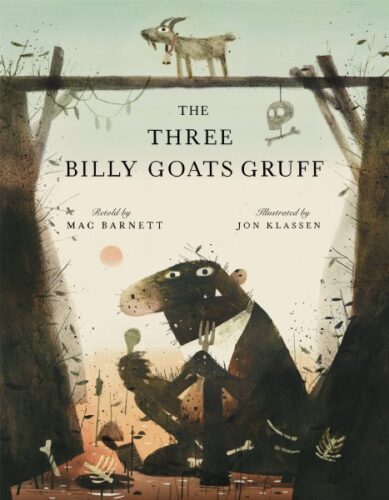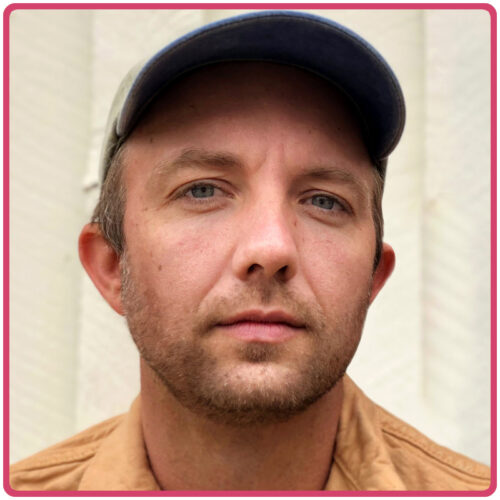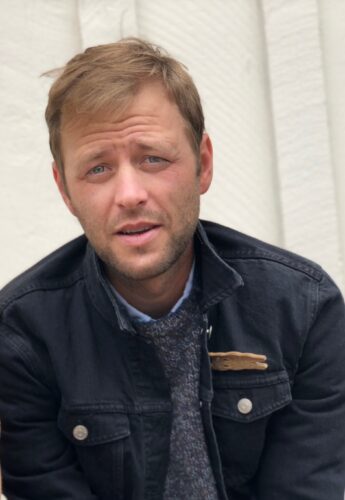Giving Me Gruff: A Jon Klassen/Mac Barnett Interview About Their Latest Goat-Related Venture
What introduction could I possibly give that would adequately introduce this legendary author/illustrator pairing? Oh you can keep your Juster/Feiffers and your Rubin/Salmieris. Give me a good old-fashioned Klassen/Barnett talk any day.
As you might have heard (or seen signing at the last ALA Conference in D.C.) John Klassen and Mac Barnett have put their own ineffable spin on the classic tale of THE THREE BILLY GOATS GRUFF. The kicker? The kicker is that there is no kicker. It’s the story, plain and simple. Well… plain and simple and hilarious.
ADVERTISEMENT
ADVERTISEMENT
I had the chance to recently ask the two about the book and all its related meanings . . .
Betsy Bird: Mac! Jon! Such a delight to talk with you folks about your latest venture. So first and foremost, I receive the PR for THE THREE BILLY GOATS GRUFF and it describes it as the “momentous debut of a groundbreaking fairy tale series”. Series, eh? Okay, I’m very intrigued. Long ago fairy tales and folk tales were the bread and butter of the publishing world. Now they often get forgotten by publishers. So what was the impetus of starting up a series of legit, faithful, fairy tales for kids?

MAC: I’ve always loved fairy tales, and for years I’d been wanting write picture book versions, but I hadn’t told anyone—probably because my sense, like yours, was that it wasn’t something a publisher would be excited about. A few years ago, my editor at Scholastic, Liza Baker, asked me to lunch and told me she wanted to run an idea by me, an idea that might seem a little out of left field, one that she knew I might not be interested in, but that she hoped I would consider with an open mind: picture book versions of fairy tales. I couldn’t believe it. I was like something out of a… wait for it… fairy tale.
BB: You’ve started off with one of my favorites, THE THREE BILLY GOATS GRUFF by Jørgen Moe and Peter Christen Asbjørnsen. Go, Norway! It’s not your usual Grimm brothers or Perrault tale, which I thought was interesting. What appealed to you about this particular fairy tale?
MAC: One thing I wanted to be sure of: that these new versions really work as picture books read-alouds. Fairy tales were first oral traditions and then recorded as straight prose, sometimes with illustrations that served a decorative (as opposed to narrative) function. So turning these stories into picture books—creating a dynamic relationship between text and image, breaking the story across page turns, and.—is a significant act of adaptation. The Three Billy Goats Gruff is such a visual story—it’s all about size, and it’s much more fun to see size than describe it. So it felt like a fun place to start.
JON: For me this story lines up with a lot of what I really like to draw. It’s a set piece, taking place over the course of one day, on one stage, from one angle, so then it’s about playing to the edges of the frame which is really fun. Most fairy tales don’t do that, and it almost feels more modern for that kind of economy. I think one of the reasons the story has lasted so long is because it’s such a clean visual setup in your mind. A bridge, a troll, some goats, go! Also, character-wise, it had elements that I’m familiar with but also some stuff I don’t normally do. The goats play it straight and stoic, which is right up my alley, but the troll is more animated, and it was fun to stretch into that a little.

BB: I think one of the most remarkable things about the book is that in spite of it following the original really closely it also made me do this really unattractive honk of a laugh in my workplace’s lunchroom one day when I turned the page and saw this amazing visual gag of the third billy goat. Jon, you both had a lot of leeway with this story but also were more confined to it than in a lot of your other collaborations with Mac. When it comes to something like the reveal of the third billy goat, how much of that is collaborative and how much is entirely you? What does your collaboration look like on a book like this?
JON: It’s a little fuzzy but I’m going to go ahead and say the mechanic of the reveal and the goat himself was my thing. I think it was my favorite turn the roughs took, when the idea came up of getting ahead of the text a little in showing the upcoming goats waiting in the wings, and it suits the story, too, because the whole point is to embarrass and punish the troll, so we as the audience get an early start on that. Getting ahead of or lagging behind the text is where I like to work best, and Mac is so good at setting up opportunities for that to happen. Our actual collaboration was pretty minimal on this one – he wrote the text before I was attached, and I tried to keep the whole thing intact. I think we tweaked a line or two, but it was in such good shape, and also a story this well-known, like you say, you don’t want the freedom to mess with it much, so the impulse was to try and treat it as a known quantity as much as possible.
MAC: Yeah, that reveal is all Jon. My manuscript had a note about the size of the third goat—
[The third Billy Goat Gruff is absolutely massive. A ridiculous step up from goat number two. The goat is bigger than the troll. Bigger than any goat. It’s hilarious.]
—but I had not thought and would never thought to put his entrance so early, which gives us those couple pages of delightful, unbearable irony. It was a brilliant move. Good job, Jon.
BB: From a language standpoint, Mac, you really dive deep into this delicious sort of rhyming chant, that changes with every goat, of all the different ways the troll is going to prepare the goats he wants to at. No shade on the goats but it’s really catchy. I don’t remember you doing all that much with rhyme before. What inspired you to include it here?

MAC: It’s funny that you felt like you had to apologize to the goats a little. And I get it: They’re the heroes of this story! But they’re not the main characters. It’s a structural quirk of The Three Billy Goats Gruff that we spend most of our time with the villain. The good guys are just passing through. Given that, I wanted to expand the troll’s character a little bit, and I liked what his poems suggested about his personality. I love verse—my second book, Guess Again!, rhymes until it doesn’t. I studied poetry in college and at various points in my life wanted to become a poet. And of course, in fairy tales it’s very common to swerve from prose to verse, so it felt right to do a little of that here.
BB: Oh right! Totally forgot about Guess Again! Good point there. Now Jon, you had all sorts of ways you could have gone with the depiction of the troll. Why did you choose to depict him the way that you did here?
ADVERTISEMENT
ADVERTISEMENT
JON: I actually took more turns on the look of him than I normally do. Character design for me is usually a very short process, but then I don’t take on tricky ones too often. The first versions of him looked more like Gollum, but we revised him a few times and what we’ve got is really useful and probably looks more like one of my guys than he did initially. He didn’t have a big nose initially, but in stories like this, where everyone is against a stage, it helps to have a nose to make it clear where the character is facing. Color-wise, my main idea was that he kind of merge with the hillside. All my favorite drawings of trolls, the unifying feature is that they look like they’re almost one with the ground, coming up out of it. If you’re crossing a little bridge, make sure you look hard down there, you might not see him at first, that kind of thing. The main thing we’re both really hoping comes out of this book is a renewed fear of crossing small bridges.

BB: Mac, I can’t tell you the number of Billy Goat Gruff versions I’ve seen that ultimately redeem the troll at the end. There was something hugely cathartic seeing you pretty much adhere to the original story with this book. Were you ever inclined to change the ending or were you dead set on making it that way from day one?
MAC: I’m glad you find it cathartic! So do I. Jon and I sometimes say that we’re more interested in consequences than redemption. Of course, sometimes redemption is a consequence, the inevitable result of plot and character. And that’s great! Redemption is one of literature’s great themes—but only one of them. But I do think the insistence on the epiphanic mode—the orthodoxy that characters must redeem themselves, improve themselves, and learn big lessons—is having a warping effect on children’s literature. There are a lot unconvincing conversions on page 31. This problem is way bigger than The Three Billy Goats Gruff—and I’m sure there are successful versions of the story where the troll repents!—but to me it feels right and important that the troll is punished.
Damn right.
Like I always say, if you want to get a good interview, you get good sources. Can’t thank Mac and Jon enough for talking with me today and answering my questions. Thanks too to Elisabeth Ferrari and the folks at Scholastic for putting this together. THE THREE BILLY GOATS GRUFF is on shelves as of October 18th so be sure to look for it then!
And finally, from their lips to your ears:
And the trailer…
Aw, heck. Why not hear them read from it as well?
Filed under: Interviews
About Betsy Bird
Betsy Bird is currently the Collection Development Manager of the Evanston Public Library system and a former Materials Specialist for New York Public Library. She has served on Newbery, written for Horn Book, and has done other lovely little things that she'd love to tell you about but that she's sure you'd find more interesting to hear of in person. Her opinions are her own and do not reflect those of EPL, SLJ, or any of the other acronyms you might be able to name. Follow her on Twitter: @fuseeight.
ADVERTISEMENT
ADVERTISEMENT
SLJ Blog Network
2024 Books from Pura Belpré Winners
Winnie-The-Pooh | Review
Parsing Religion in Public Schools
ADVERTISEMENT






